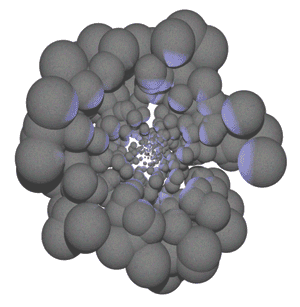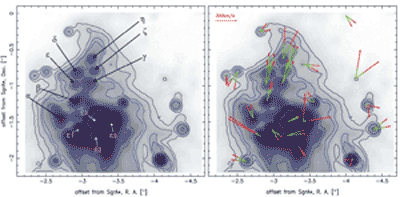Highlights - Volume 482-1 (April IV 2008)
- Details
- Published on 01 April 2008
| HIGHLIGHTS: this week in A&A |
Volume 482-1 (April IV 2008)
| In section 4. Extragalactic astronomy “Three-dimensional radiative transfer models of clumpy tori in Seyfert galaxies”, by M. Schartmann et al., A&A 482, p. 67 Schartman et al. have undertaken a serious study of Monte Carlo 3D radiative transfer in a clumpy medium to better understand the emission of active nuclei, in particular Seyfert2. Their model is one of the most elaborated, and for the first time they study the various degrees of clumpiness in the "tori", which are the main ingredient of unified models for AGN. They show how the heating, the shadowing effects, absorption, and emission compare between clumpy and smooth distributions. They apply their model to the high-resolution (MIDI interferometer), mid-infrared observations of Circinus. |
|
| In section 5. Galactic structure, stellar clusters, and populations “IRS 13N: a new comoving group of sources at the Galactic center”, by K. Muzic et al., A&A 482, p. 173 The existence of stellar clusters in the very close vicinity of the Galactic center remains a puzzle, since since it is predicted that they only briefly survive in the strong tidal field of the central supermassive black hole. Authors focus on one such cluster, which also is made up of unusually red stars. They demonstrate that those are comoving and suggest that they are very young rather than evolved dusty stars, although neither interpretation is fully without problems. |
|
| In section 10. Planets and planetary systems “Structure and evolution of super-Earth to super-Jupiter exoplanets.I. Heavy element enrichment in the interior”, by I. Baraffe et al., A&A 482, p. 315 Some of the transiting extrasolar planets that have been found over the past decade have significantly larger radii than predicted by models with standard input physics. That conclusion, however, was weakened by incomplete exploration of the error bounds of those models. The authors critically examine many assumptions that have gone into extrasolar giant planet modeling, thus raising the bar for what should be included in state-of-the-art giant exoplanet models. This will put the need for additional physics (such as additional energy sources or impeded energy transport) on an even firmer basis. |
© Astronomy & Astrophysics 2008



